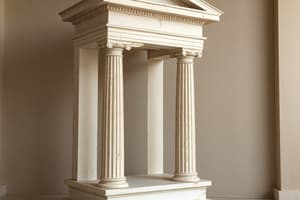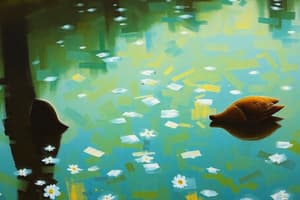Podcast
Questions and Answers
What does the Aryan root 'Ar' mean in relation to art?
What does the Aryan root 'Ar' mean in relation to art?
- To join or put together (correct)
- To imitate nature
- To express emotions
- To create or invent
How did the definition of art evolve prior to the Renaissance?
How did the definition of art evolve prior to the Renaissance?
- Art was synonymous with craft. (correct)
- Art was seen as merely a form of entertainment.
- Art was defined primarily as a scholarly discipline.
- Art was exclusively reserved for aristocratic expressions.
According to modern definitions, what two elements are crucial in the formal expression of art?
According to modern definitions, what two elements are crucial in the formal expression of art?
- Nature and nurture
- Form and substance (correct)
- Emotion and thought
- Style and technique
What statement reflects Aristotle's view on art?
What statement reflects Aristotle's view on art?
Why is it stated that 'ART IS NOT NATURE'?
Why is it stated that 'ART IS NOT NATURE'?
What primarily distinguishes plastic arts from other forms of artistic expression?
What primarily distinguishes plastic arts from other forms of artistic expression?
Which of the following is NOT an example of the representational plastic arts?
Which of the following is NOT an example of the representational plastic arts?
What characterizes nonrepresentational plastic arts?
What characterizes nonrepresentational plastic arts?
In decorative applied art, which aspect is frequently used?
In decorative applied art, which aspect is frequently used?
How are architectural images and some monumental artworks primarily appreciated?
How are architectural images and some monumental artworks primarily appreciated?
Flashcards are hidden until you start studying
Study Notes
The Origin of "Art"
- "Art" originates from the Aryan root "Ar," meaning "to join" or "put together."
- The root "Ar" gave rise to Greek verbs "Artizein" (to prepare) and "Arkiskein" (to put together).
- Latin terms "Ars" and "Artis" signify anything man-made or composed.
Evolution of the Word "Art"
- Before the Renaissance, "art" referred to craftsmanship.
- In modern times, "art" is primarily associated with fine arts.
Philosophical Definition of Art
- Aristotle defined art as "the right reason for making things."
- Art involves human activity directed towards transforming or changing based on principles.
- Modern art is defined as a formal expression of a human experience, emphasizing form and substance.
Distinguishing Art from Nature
- Art is man-made, in contrast to nature.
- Nature serves as the foundation for art by supplying subject matter and materials.
The Relationship Between Art and Life
- Art imitates life, according to Aristotle.
- Despite imitating life, art remains a product of human creativity.
Spatial Arts
- A concept that encompasses forms of art, whose works exist within space, remain static in time, and are visually perceived.
Plastic Arts
- Arts that involve physically manipulating a material medium, with the medium's composition heavily influencing the work's structure.
- Divided into representational and nonrepresentational categories.
Representational Plastic Arts
- Includes painting, sculpture, graphics, and photography.
- These arts reproduce visually perceived reality with varying degrees of accuracy.
- Sculpture is three-dimensional, while painting, graphics, and photography are two-dimensional.
Nonrepresentational Plastic Arts
- Include architecture, decorative applied art, and artistic design.
- They don't necessarily rely on real-world models for their visual-spatial forms.
Blurred Boundaries
- The distinction between representational and nonrepresentational arts isn't absolute.
- Decorative applied art often uses figurative motifs, while some nonrepresentational works can also be considered representational (e.g., figurative vessels in sculpture).
- Architecture, although nonrepresentational, sometimes incorporates forms from nature (e.g., ancient Egypt).
Temporal Element
- Plastic arts differ from other art forms due to their lack of temporal development.
- Forms are static, unlike music, which unfolds in time.
Visual and Tactile Perception
- Plastic arts are primarily appreciated through sight, with sculpture and decorative applied art allowing for tactile interaction.
- Understanding and appreciating architectural images and some monumental paintings and sculptures requires motor perception, which takes time, but the work itself remains unchanged.
Fusion with Other Arts
- Artists specializing in plastic arts often contribute to other, more synthetic art forms.
- Painters, architects, and sculptors participate in theatre, film, and festival decor.
- Attempts have been made to merge painting and music (e.g., Scriabin's "color music").
Integration of Language
- Language plays a significant role in plastic arts, particularly in specific periods and art forms.
- Text is integral to posters, caricatures, and cheap popular prints.
- Words complement the image in Greek vase painting, medieval icons and miniatures.
- In architecture, inscriptions (e.g., Roman triumphal arches) and even entire texts (ancient Egyptian temples, medieval mosques) serve as visual elements.
- Titles of pictures and sculptures often relate to their content.
Structure of Plastic Images
- Visual-plastic means form the basis of images in plastic arts: composition, elements of form (space, volume, movement, rhythm, line, chiaroscuro, color), and technique.
Analytical Structure of Artistic Image
- Can be broken down into three interconnected aspects:
- Tectonic-compositional: Involves organizing the medium in space (three-dimensional in architecture, sculpture, etc., and two-dimensionally in painting, graphics), establishing structure and tectonics, arranging elements harmoniously or inharmoniously, and achieving compositional unity.
- Expressive: Achieved through visual-formal elements that evoke certain emotions and moods.
- Representational: Refers to the depiction of reality, whether with accuracy or symbolically.
Conclusion
- The unity of tectonic-compositional, expressive, and representational aspects reveals the ideological and artistic meaning of a plastic artwork.
Studying That Suits You
Use AI to generate personalized quizzes and flashcards to suit your learning preferences.




